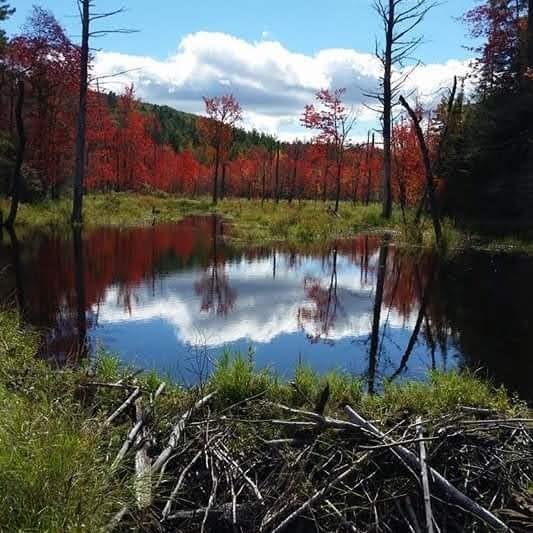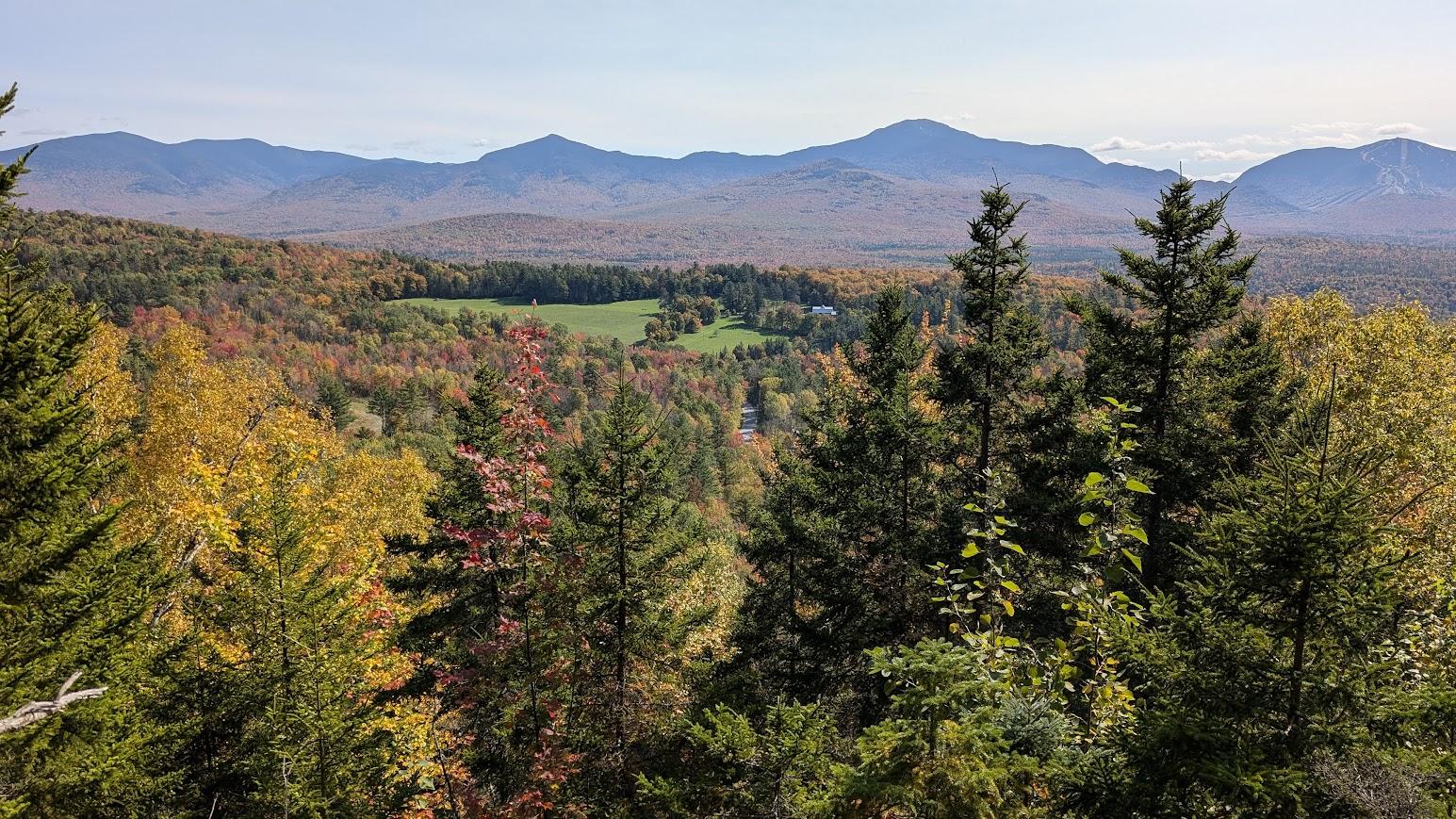2024 A Great Year for Fall Foliage
- Tags:
- Forest Journal,
- Recreation,
- Wildlife

Fall foliage reflected in Ashuelot River beaver pond. (Photo: Sue Lichty)
I went out a limb with a bold and colorful fall foliage season prediction this year: “It will be the best foliage season in a decade.”
Why? Because we enjoyed a perfect ‘Goldilocks summer’ - not too wet, not too dry, not many insect pests of statewide significance. The majority of hardwood leaves remained intact and green on a gazillion trees in New Hampshire’s forest canopy. Green leaves in September portend a slow turning – weeks of perfect fall colors. Thus far, its been true.
Oh sure, some Eeyore-types in Winnie The Pooh’s “Hundred Acre Wood” point to a sickly street tree or to a region where caterpillar outbreaks or heavy rains took a toll in 2023 and extrapolate individual tree health to wider statewide forests, but they are barking up the wrong tree. Experts know that pre-season foliage stories lean-in to dire predictions. But this is not the year for doomsayers reading tea leaves. This year, the leaves are changing right on time: not too early, not too late. The only spoiler would be wind-driven heavy rain or remnants of an Atlantic or Gulf Coast hurricane but those too have veered-away from New England.
Foliage predicting is not a precise science but neither are long-range weather forecasts. Its more about watching trends. Weather and foliage quality are related. Summer rains or droughts can play a role. So do bright, sunny days and cool frosty nights that make red colors really pop on maples. But the real driver is longer nights and shorter days which recur every year.
This year the foliage will be awesome. Leaves change color and fall off every year to greater or lesser acclaim. It’s how people respond, remember and rake (or not) that gets interesting…

Cha-Ching! Economic tourism.
In September, the NH Division of Travel and Tourism Development announced its fall foliage season forecast: “Approximately 3.7 million people are expected to visit New Hampshire; spending by those visitors is estimated to reach $1.8 billion dollars. The numbers remain consistent with visitation and spending from last fall”
Cha-ching! Fall tourism nearly triples our state’s year-round population of 1.4 million residents during a brief month-long season. The imagery that defines the NH identity invariably includes foliage. Colorful trees are a powerful drawing card.
Come Christmas time, people lament commercialism by imploring “remember the reason for the season.” The rustle of autumn leaves and ring of cash registers right now seems to suggest — “Ahem” — perhaps the forests themselves should receive a sliver of the tourism revenue? Not everyone is here for tax-free shopping. Foliage season stems from those red, orange and yellow colors of forestlands which cover roughly 81% of the state. It’s an impressive feat that inanimate trees can draw an audience akin to a Taylor Swift tour. Oh and T-Swift? Yep — raised on a Christmas tree farm.
Why the leaves leave
The physiology of fall color has more to do with decreasing daylight than temperature or precipitation. Plants are light-eaters that measure daylight in their leaves via chemicals and hormones. As daylight wanes in late summer, trees adapted to northern climates prepare for winter by slowing their growth rate, shutting down photosynthesis, hardening tiny leaf and flower buds for next spring and forming a waxy cuticle layer over evergreen needles to prevent drying out in the cold.
Hardwood trees are specially adapted to lose their leaves by forming a corky layer at the base of leaf stems. Production of green chlorophyll stops. Secondary leaf pigments are now revealed: yellow “xanthophylls” and orange “carotenes” were present all summer beneath the green. Before leaves fall, sugars are shipped to the root-cellar to be stored as stable starch to fuel next year’s growth. In the presence of bright sunlight, a different pigment is produced from residual sugars now trapped in the leaves: red “anthocyanin.” The red color is most common in red maple, sugar maples, black gum, staghorn sumac and Virginia creeper vines — all famous for vivid crimson colors. Sunlight increases that production of red — so sunny weather amplifies vivid red in the outermost leaves at the tips of branches.
Multiple peaks
There is no such thing as a “peak” fall foliage, a mythic phenomenon some regard like a moment of totality during the recent solar eclipse. Here’s why: there are multiple peaks. Colors change regionally and vary with latitude, altitude, slope, aspect and local terrain. Forest types vary by soils that are a function of glacial history and previous land use.
The Southeast, Seacoast region of NH is glacial outwash: sandy and well-drained soils that grow pine, hemlock, oak and hickory hardwood forests. The central Lakes Region and western highlands are rocky glacial till: bony soils that grow a transition northern hardwood forest of beech, white birch, yellow birch and red and sugar maple. In the White Mountains and North Country, the colorful northern hardwoods are mixed into a matrix of boreal red spruce and balsam fir – a land of pointy trees where the contrast of yellow birch and beech leaves against dark conifers reaches peak a week or two before the southern part of the state.
In wetlands, shallow soils or rocky boulders below cliffs, trees under stress exhibit colors earlier. Often the red maples are the last to leaf out in spring and the first to lose their leaves in September. Oaks and beech in southern NH fade from green to yellow and then bronze – 3rd place leaves that remain on many trees well into November.
The “mood thing.”
People respond to autumn with colorful variations of their own. Internet, smartphones and social media venues have been a foliage season game changer. Influencers and marketing pros publish Top Ten suggestions for Instagram-ready iconic photo locations. This is where the alchemy of red brick and white clapboard architecture of a center meetinghouse or a covered bridge against a backdrop of forest-clad mountains blends natural and cultural history. Watch for photos of the earliest light dusting of snow in the high peaks of the White Mountains. People flock to find locales famed for foliage reflected in the mirror of placid ponds, seeking sparkling lakes, rural roads and small towns. New Hampshire arguably looks its best in autumn splendor.
There are undeniable life metaphors too. Autumn is our golden years, winding down the natural year with the approach of winter darkness. We embrace a collective mood of nostalgia: apple-picking, pie baking, cinnamon, nutmeg and pumpkin spice experiences people seem to crave. Rake up a pile of leaves, then roll around in them- that’s autumn nostalgia. It’s time to make new memories of your own perfect autumn weekend.
